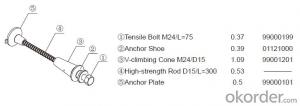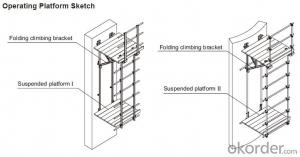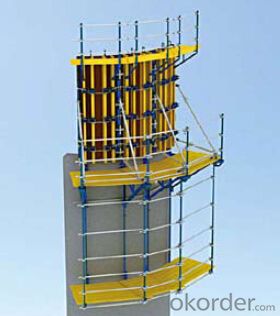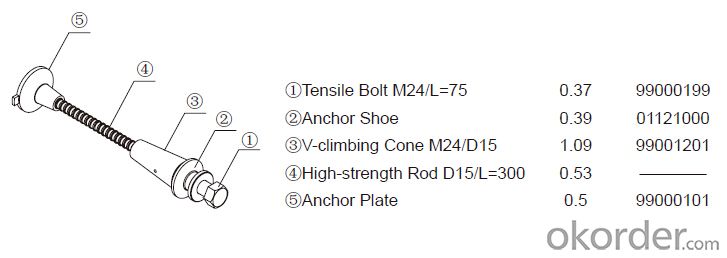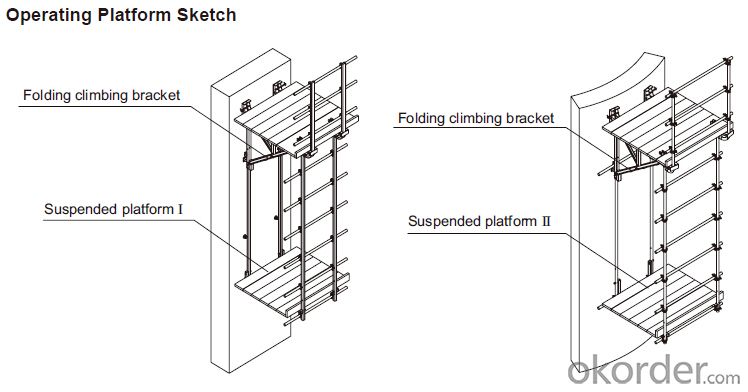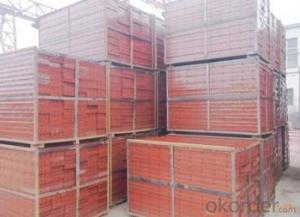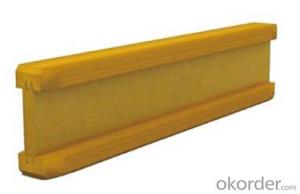Climbing Platform CP--190 for formwork and scaffolding system
- Loading Port:
- Tianjin
- Payment Terms:
- TT OR LC
- Min Order Qty:
- 50 m²
- Supply Capability:
- 1000 m²/month
OKorder Service Pledge
OKorder Financial Service
You Might Also Like
Climbing Platform CP190
Climbing bracket CP190 is mainly used as operating platform during construction. It can be used
on the vertical wall and arced wall. The bracket hang on the anchor system and all the load are
supported by anchor system. It’s convenient to assemble and dismantle, the construction is easy,
rapid and safe.
Anchor System:
Anchor system is the most important supporting part. The system is made of five parts shown
below. There into, tensile bolt, anchor shoe and V-climbing cone can be taken out for reusing.
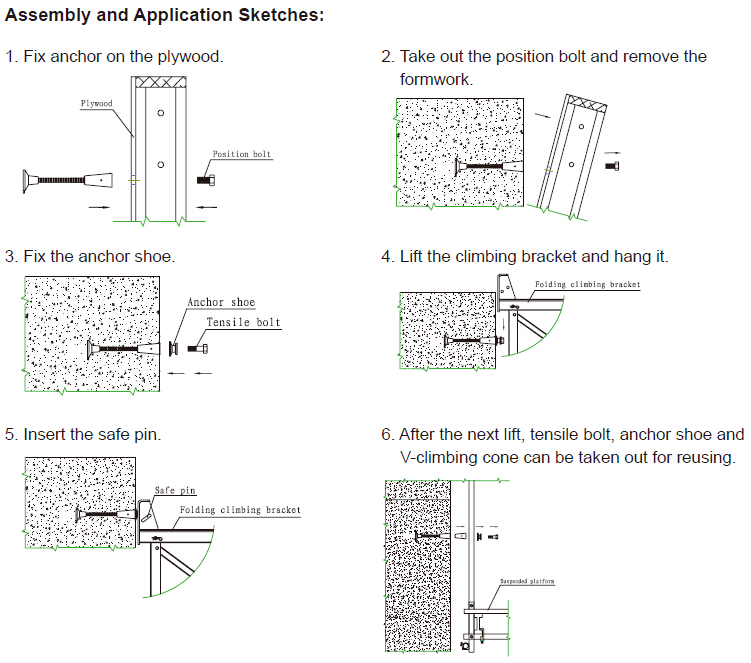
- Q: How does steel formwork perform in seismic zones?
- Due to its high strength and durability, steel formwork is an excellent choice for seismic zones. The robustness of steel enables it to withstand the intense shaking and vibrations caused by earthquakes, as it has outstanding load-bearing capacity and resistance to bending and shearing forces. During an earthquake, seismic zones experience significant ground movement, which exerts immense pressure on the formwork system. However, steel formwork remains rigid and strong, preventing any significant deformation or damage. This ensures the stability and integrity of the structure both during and after the seismic event. Furthermore, steel formwork provides flexibility in design and construction, allowing for reinforced concrete structures that can better handle seismic loads. Additional reinforcement elements, such as steel bars and mesh, can be incorporated with the use of steel formwork, enhancing overall strength and ductility. This helps dissipate the energy generated by seismic forces and reduces the risk of structural failure. In addition to its performance, steel formwork is also cost-effective and sustainable in seismic zones. It can be easily dismantled and reassembled, making it reusable and facilitating quick repair and reconstruction in the event of earthquake damage. This minimizes downtime and ensures the safety of occupants. In conclusion, steel formwork is a reliable and resilient choice for construction in seismic zones. Its strength, durability, and flexibility make it well-suited to withstand the forces generated by earthquakes, ensuring the safety and stability of structures in these high-risk areas.
- Q: Can steel formwork be used for airport construction projects?
- Yes, steel formwork can be used for airport construction projects. Steel formwork is a versatile and durable option for constructing various concrete structures, including those found in airports. It offers several advantages such as high strength, stability, and reusability, making it suitable for large-scale projects like airport construction. Steel formwork can withstand the heavy loads and pressures associated with airport infrastructure, allowing for the construction of runways, taxiways, aprons, and other structures. Additionally, its modular design and flexibility enable easy customization and adaptation to different project requirements. Overall, steel formwork is a reliable choice for airport construction projects due to its strength, durability, and adaptability.
- Q: How does steel formwork contribute to the overall efficiency of concrete construction?
- Steel formwork contributes to the overall efficiency of concrete construction by providing a durable and reusable framework for pouring concrete. It offers a high level of accuracy and precision in shaping the concrete, ensuring that the desired dimensions and finishes are achieved. This leads to a reduction in material wastage and labor costs. Additionally, the strength and stability of steel formwork allows for faster construction cycles, enabling projects to be completed on time or ahead of schedule.
- Q: What are the different types of formwork bracing used in steel formwork?
- There are several types of formwork bracing used in steel formwork, including diagonal braces, horizontal braces, vertical braces, and cross braces. These bracing elements are essential for providing stability and support to the formwork system, ensuring the safe construction of concrete structures.
- Q: Can steel formwork be used for underground culverts?
- Yes, steel formwork can be used for underground culverts. Steel formwork is durable and strong, making it suitable for withstanding the pressure and weight of the surrounding soil and water in underground culverts. It provides a stable and rigid structure that can be easily assembled and disassembled, allowing for efficient construction and maintenance of underground culverts.
- Q: How does steel formwork handle different concrete surface repair techniques?
- Steel formwork proves to be a versatile and durable choice for managing various techniques used in concrete surface repair. The primary advantage of steel formwork lies in its ability to withstand the pressures and stresses associated with concrete repairs. When it comes to methods like patching or resurfacing, steel formwork acts as a sturdy and stable framework for containing the concrete mixture. It can bear the weight of the repair materials and the pressure exerted by the concrete during the setting and curing process. This guarantees proper containment of the repair and ensures the achievement of the desired shape and dimensions. Moreover, steel formwork offers flexibility in terms of shape and design. It can be easily customized to meet different repair requirements, whether it involves straight surfaces, curves, or complex geometries. The strength of steel enables the creation of intricate formwork structures capable of handling even the most challenging repair projects. Furthermore, steel formwork exhibits excellent reusability and durability. It can be reused multiple times without significant wear and tear, making it a cost-effective solution for numerous repair projects. This durability ensures the formwork's integrity remains intact throughout the repair process, preventing any potential issues and maintaining the repair's quality. Additionally, steel formwork possesses resistance to moisture and chemicals, commonly present in concrete repairs. This resistance ensures that the formwork remains in good condition, avoiding any corrosion or deterioration when in contact with the repair materials. This becomes particularly crucial for long-term repairs where the formwork may remain in place for an extended period. In conclusion, steel formwork emerges as a dependable and efficient option for managing various concrete surface repair techniques. Its strength, flexibility, reusability, and resistance to moisture and chemicals make it an ideal choice for containing and shaping the repair materials, ultimately leading to successful and durable repairs.
- Q: How does steel formwork accommodate for different concrete pouring rates?
- Steel formwork can accommodate different concrete pouring rates by its ability to withstand high pressures exerted by the concrete. The strength and rigidity of steel allow it to contain and support the concrete, regardless of the speed at which it is poured. This ensures that the formwork remains stable and intact, preventing any deformations or collapses during the pouring process.
- Q: What are the different accessories required for steel formwork maintenance?
- The following are the various accessories needed to maintain steel formwork: 1. To maintain the smooth surface of the formwork and prevent corrosion or damage, formwork cleaning agents are used to remove any concrete residue or build-up on the steel formwork. 2. Prior to pouring concrete, formwork release agents are applied to the steel formwork to prevent it from sticking. This makes it easier to remove the formwork once the concrete has cured. 3. Formwork patching compounds are used to fix any damages or imperfections on the steel formwork. This helps maintain the formwork's structural integrity and ensure its longevity. 4. To ensure smooth operation and prevent friction or wear and tear, formwork oil or grease is applied to the moving parts of the steel formwork, such as hinges or sliding mechanisms. 5. Formwork ties and connectors are used to secure the formwork panels together during concrete pouring, ensuring stability. They should be regularly inspected and replaced if damaged or worn out. 6. Formwork wedges and pins are used to align and secure the formwork panels in place. Regular checks should be done to ensure proper positioning and stability. 7. Formwork clamps and brackets are accessories used to support and hold the formwork panels in position. They should be inspected for any signs of damage or weakness and replaced if necessary. 8. To clean the steel formwork and prevent the accumulation of dirt or debris, formwork cleaning tools such as brushes, scrapers, and high-pressure washers are used. 9. Racks, trolleys, or storage containers are used as storage and transportation equipment for the steel formwork. Proper storage and transportation ensure the formwork's longevity and prevent any damage or distortion. In summary, the various accessories needed for steel formwork maintenance are essential for optimal performance, durability, and safety during concrete construction projects.
- Q: How does steel formwork prevent concrete segregation?
- Steel formwork helps prevent concrete segregation by providing a rigid and stable structure for the concrete to be poured into. Unlike other types of formwork materials such as wood or plastic, steel formwork maintains its shape and prevents any movement or deformation during the pouring and curing process. Concrete segregation occurs when the different components of concrete, such as cement, aggregates, and water, separate from each other, resulting in an uneven distribution of these components within the mixture. This can weaken the concrete structure and lead to various issues such as reduced strength, cracking, or voids. Steel formwork prevents concrete segregation by offering a smooth and even surface for the concrete to be poured onto. The rigid nature of steel ensures that there are no gaps or spaces for the components of the concrete to separate or settle unevenly. This helps to maintain a consistent and uniform distribution of the cement, aggregates, and water throughout the entire concrete mixture. Additionally, steel formwork provides a tight seal against the sides and bottom of the form, preventing any leakage or loss of moisture during the curing process. This helps in maintaining the required water-cement ratio, which is crucial for the proper hydration and hardening of the concrete. By preventing excessive evaporation or moisture loss, steel formwork ensures that the concrete cures evenly, reducing the chances of segregation. Furthermore, the use of steel formwork allows for precise and accurate placement of the concrete, eliminating any potential gaps or voids that could contribute to segregation. The steel formwork can be designed with various features such as tie rods, clamps, or connectors to hold the formwork panels securely in place, ensuring that the concrete is poured and compacted uniformly. In summary, steel formwork prevents concrete segregation by providing a stable and rigid structure that maintains the shape and integrity of the concrete mixture. It prevents the separation of components, ensures a consistent distribution of materials, and allows for precise and accurate placement of the concrete, resulting in a stronger and more durable structure.
- Q: How does steel formwork handle construction joints?
- Steel formwork is a versatile and durable option when it comes to managing construction joints. Its design is specifically tailored to meet the demands of construction joints, ensuring a seamless and efficient construction process. To begin with, steel formwork boasts strength and stability, enabling it to withstand the pressure and weight exerted on construction joints. This guarantees that the formwork remains intact and firmly in place, even during the pouring and compacting of concrete at the joints. Furthermore, steel formwork is highly flexible and can be easily adjusted to accommodate different shapes and sizes of construction joints. This allows for precise and accurate placement of the formwork, guaranteeing proper formation and alignment of the joints. Moreover, steel formwork is reusable, making it a cost-effective choice for managing construction joints. Once the concrete has fully cured and the formwork is removed, it can be cleaned, repaired if necessary, and utilized again for future construction projects. This reduces the need for additional formwork materials and minimizes waste. Additionally, steel formwork provides a smooth and uniform surface finish, which is crucial for construction joints. It aids in preventing any leakage or seepage of concrete at the joints, ensuring that the structure remains watertight and structurally sound. In conclusion, steel formwork is an exceptional option for handling construction joints. Its strength, flexibility, reusability, and ability to provide a smooth surface finish make it a dependable and efficient solution for construction projects of varying sizes and complexities.
Send your message to us
Climbing Platform CP--190 for formwork and scaffolding system
- Loading Port:
- Tianjin
- Payment Terms:
- TT OR LC
- Min Order Qty:
- 50 m²
- Supply Capability:
- 1000 m²/month
OKorder Service Pledge
OKorder Financial Service
Similar products
Hot products
Hot Searches
Related keywords

